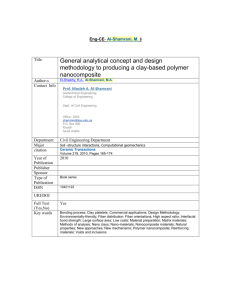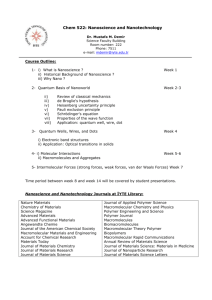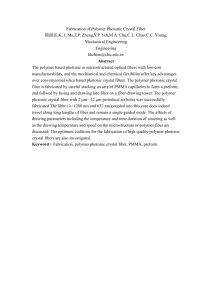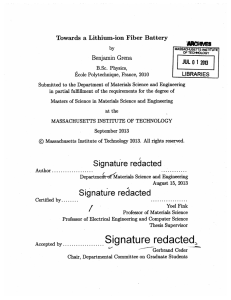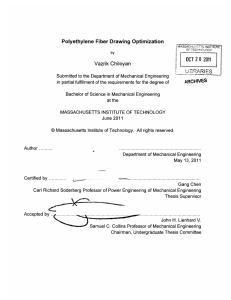Statement of purpose 纳米:好看 高分子 第一段: 大二上我证明我的学习
advertisement
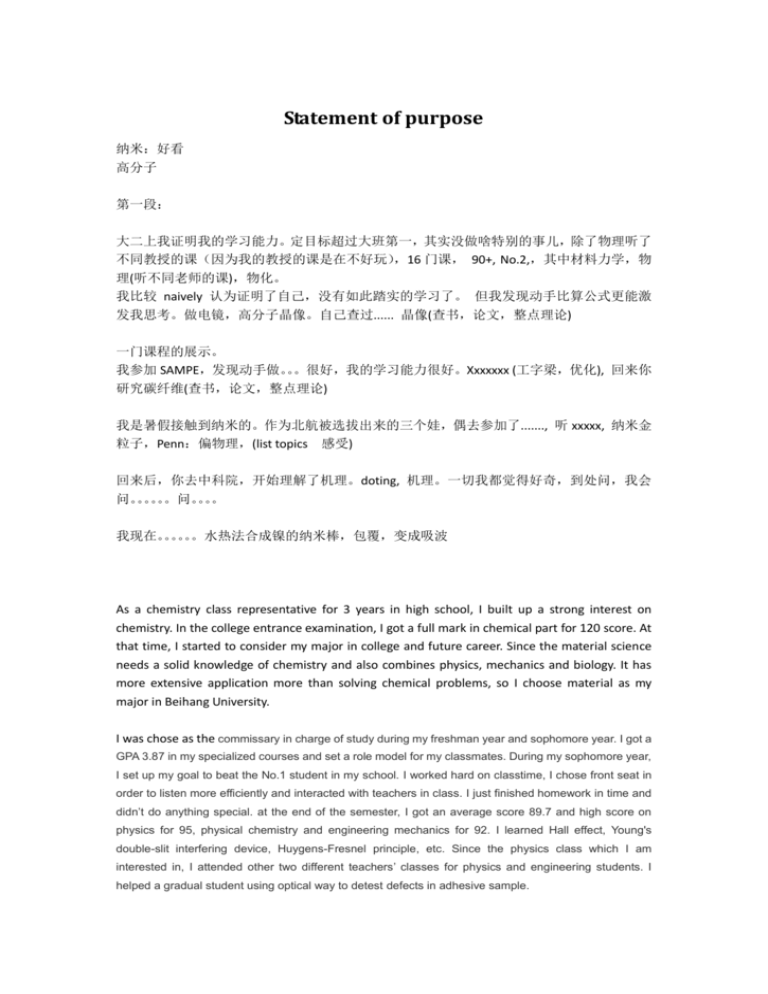
Statement of purpose 纳米:好看 高分子 第一段: 大二上我证明我的学习能力。定目标超过大班第一,其实没做啥特别的事儿,除了物理听了 不同教授的课(因为我的教授的课是在不好玩),16 门课, 90+, No.2,,其中材料力学,物 理(听不同老师的课),物化。 我比较 naively 认为证明了自己,没有如此踏实的学习了。 但我发现动手比算公式更能激 发我思考。做电镜,高分子晶像。自己查过...... 晶像(查书,论文,整点理论) 一门课程的展示。 我参加 SAMPE,发现动手做。 。 。很好,我的学习能力很好。Xxxxxxx (工字梁,优化), 回来你 研究碳纤维(查书,论文,整点理论) 我是暑假接触到纳米的。作为北航被选拔出来的三个娃,偶去参加了......., 听 xxxxx, 纳米金 粒子,Penn:偏物理,(list topics 感受) 回来后,你去中科院,开始理解了机理。doting, 机理。一切我都觉得好奇,到处问,我会 问。 。 。 。 。 。问。 。 。 。 我现在。 。 。 。 。 。水热法合成镍的纳米棒,包覆,变成吸波 As a chemistry class representative for 3 years in high school, I built up a strong interest on chemistry. In the college entrance examination, I got a full mark in chemical part for 120 score. At that time, I started to consider my major in college and future career. Since the material science needs a solid knowledge of chemistry and also combines physics, mechanics and biology. It has more extensive application more than solving chemical problems, so I choose material as my major in Beihang University. I was chose as the commissary in charge of study during my freshman year and sophomore year. I got a GPA 3.87 in my specialized courses and set a role model for my classmates. During my sophomore year, I set up my goal to beat the No.1 student in my school. I worked hard on classtime, I chose front seat in order to listen more efficiently and interacted with teachers in class. I just finished homework in time and didn’t do anything special. at the end of the semester, I got an average score 89.7 and high score on physics for 95, physical chemistry and engineering mechanics for 92. I learned Hall effect, Young's double-slit interfering device, Huygens-Fresnel principle, etc. Since the physics class which I am interested in, I attended other two different teachers’ classes for physics and engineering students. I helped a gradual student using optical way to detest defects in adhesive sample. Motivated by the strong will to carry out what I had learned in class, I attended the “SAMPE CHINA 2010 Conference” and participated in “the 2nd SAMPE International Super Lightweight Composite Student Contest”. During three mouths, we designed five types of composite bridge and evaluated each design using theory of engineering mechanics. Since carbon fiber has strong stiffness and strength along the fiber direction while weak on vertical direction, by using ANSYS, I compared drawbacks of each model and meliorated bridges into maximum performance. We applied the laminated plate theory to design an even and symmetrical form of bridge. We test different laying methods and measured diverse influences of processing parameters, such as the temperature and pressure, to manufacture ideal resin/carbon fiber structure in the composite. Finally, we got the third in the competition and got highly praise from the judges. After Since I proved my good capability on curricula, I spared more time on hand-on experiment which inspires me to comprehend the formation of substance under microscope and (。 。 。). When I did the polymer crystallization experiment, I was fascinated by the beautiful Maltese cross of sphaerocrystal. So I read books about polymer crystallization, such as Macromolecular Physics and The physics of polymers. In the book, I am attracted by the magic polymer with conjugated double bonds in the main chain. Since their delocalized π electron states offer a gap energy near that of light, they perform good electro-optic activity. By controlling HOMO of donor and LUMO of acceptor, scientists shift the band energy of D-A system making them more suitable to solar light. Later on, on one of my favorite class, polymer material, I did research about transparent electric conductive film used in LCD. With the strong interests in nanomaterial and conjugated polymer, I join the Opv Lab at National Centre for Nanoscience and Technology. With the increasing demand for energy and fossil fuel depletion, organic solar cells as a low cost photoelectric converter are actively pursed worldwide. However, the principle difficulties center on its limited ECE which is at most 13% and its short longevity outside the lab. Many scientists devoted on finding more efficient donor-acceptor system in a BHJ structure and the derivative of P3HT or PPV as donor materials and PCnBM as acceptor material are extensive discussed. I am interested in doting different nanoparticles into the BHJ structure to enhance the transformation of electrons, changing the band to give it a red shift and control the property of solar cells. I utilized finite-element analysis software (ANSYS) to simulate the model of the bridge. The laminated plate theory asks for an even and symmetrical laminated form to avoid stress coupling and prevent the warping deformation after solidifying. Laying principle demand a uniform distributed monolayer alone the laminated plate, so it can reduce the interlayer stress. We tested the relationship between carbon fiber prepreg and different laying methods and also measured the diverse influences of processing parameters (temperature, pressure, Auxiliary material, etc.) to the performance of carbon fiber/epoxy composites. We got the third in the competition and got highly praise from the judges. It also won the second-class prize in “Fengru Cup” the school science and technology innovation competition. I rethink profoundly that the remanent resin content in the composites and defect between layers are reasons decrease the performance of our work. And we should enhance the upper surface with more prepergs. The winning inspired me to develop my interest on nanoscience. Last summer I applied the first summer school hold by camp-nano (center for advancing materials performance from the nanoscale) in Xi’an Jiaotong University and stood out from more than one hundred applicants nationwide. Prof. Li Ju who is from Upenn and prof. Yin Yadong from UCR gave us lectures about frontier technologies in nanoscience. The physical and chemical properties of nanoparticles depend strongly on their size and shape, and I am so interested in the beautiful shapes of different nanostructure and special performances at nanoscale. I visited the Focused ion beam lab(with PI 85 SEM PicoIndenter, X-Max Large Area EDS SDD (50mm2), EBSD and Kleindiek Mechanical Manipulator), TEM Laboratory(with JEOL 2100 FEG TEM, PI 95 TEM PicoIndenter and PI 95 TEM PicoIndenter with Nano ECR) and Multi-field Nano Mechanics Lab(TI 950 Introduction).


